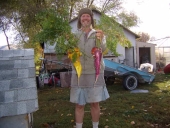There's a lot of people out there who say permaculture can't be applied at a commercial scale.
Maybe it's not exactly true, check this out :
Twenty years ago, Stefan Sobkowiak bought a 12-acre commercial apple orchard with the intention of converting it to an organic orchard. He did just that, but eventually understood the limitations of the organic model originating from monoculture. He then decided to tear out most of the trees and replant in a way that would maximize biodiversity and yield while minimizing maintenance. Inspired by permaculture principles, the orchard now counts over 100 cultivars of apples, plus several types of plums, pears, cherries, and countless other fruits and vegetables.
By maximizing biodiversity, the system established by Stefan attracts a huge number of pollinators and other insects, but also birds and other types of animals. This not only helps to control pests, but increases the yields and reduces the amount of work needed. Mixing in nitrogen fixing trees among fruit trees also helps create fertility and eliminates the need for external inputs of fertilizers, resulting in a circular eco-system that takes care of itself.
Everything is organized following what Stefan calls a grocery aisle concept, where everything in one row will be ripe and ready to harvest within a 10-day window. This allows efficient harvesting despite the huge diversity of species, and could be a very useful model for large-scale commercial fruit growing.








